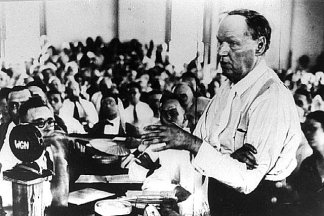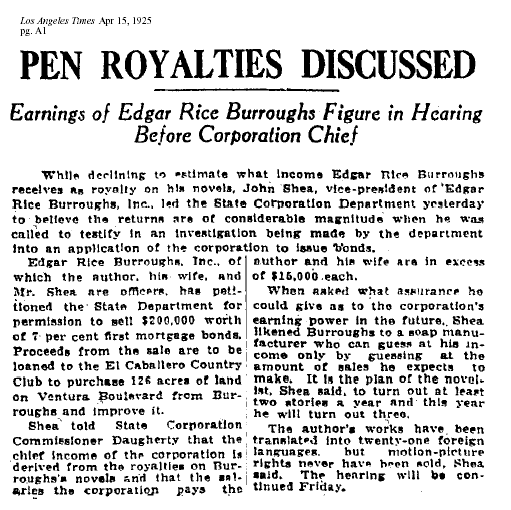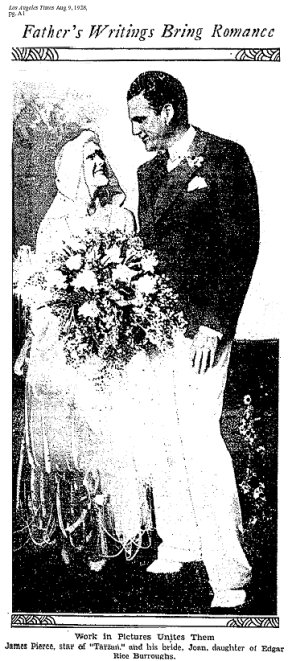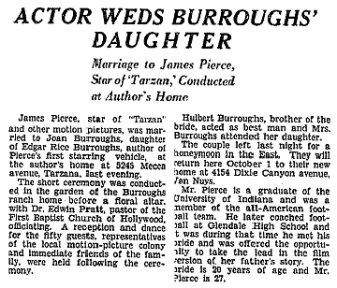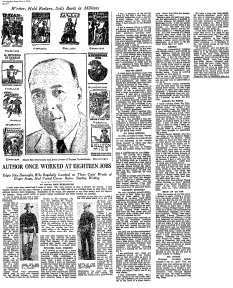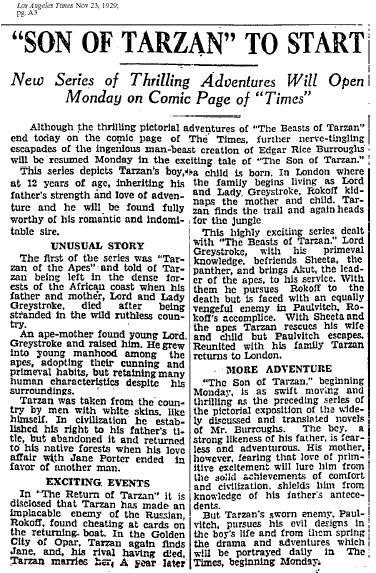THE SADDLE HORSE IN SOUTHERN
CALIFORNIA
Bridle Path System Linking
Los Angeles with sea and Mountains
Gives Horsemen Advantages
Such as Few Other Cities Enjoy
By Edgar Rice Burroughs
Los Angeles Times ~ January
1, 1925
Winding canyons between green hillsides;
oaks centuries old; great sycamores, gnarled into fantastic shapes; a bridle
path now in the shade of evergreen foliage to break again upon a
grassy meadow-land; a good foliage at your right -- a deer, perhaps, a
coyote or a mountain lion; fresh air, the exhilaration of movement and
of freedom, the electric tingling of the nerves imparted to you from the
high-strung, powerful living thing beneath you -- this is the joy of the
horseman in Southern California.
So vast is the area covered by mountain
trails within the limits of the city that one may ride day after day without
encountering another horse-man, yet we know that there are 606 horses in
our local commercial stables with an average of nearly 2500 rides each
week, and these in addition to many privately owned stables which are constantly
growing in number.
And why all this equestrian activity?
Perhaps this question is best answered by quoting from an article by Dr.
A. J. Ochsner of Augustana Hospital, Chicago, one of America's noted
surgeons:
It is my object to point
out the actual value of horseback riding systematically carried out, in
increasing a man's possibilities in the way of being a productive member
of society.
There is no other form of exercise
that so fully affects every nerve and every organ of the human body in
a healthful way as does horseback riding. Moreover, the rider's attention
is centered upon his horse, so that he cannot and will not let his business
or professional troubles interfere with the pleasure of the ride. Nothing
will bring out a healthy glow more quickly or enjoyably than this exercise.
Nothing will more promptly put one's organs of digestion and those of elimination
into the way of performing their physiologic work properly. On horseback,
one is forced to breathe deeply, and this, in the open air, in itself means
an enormous advantage to a man who spends his working hours in intensive,
concentrated mental activity.
What has been said regarding adults
applies with equal force to boys and girls. Nothing can be of greater benefit
in their physical, intellectual and moral development than systematic horseback
riding. It will go far to outweigh the handicap of living in the city.
The value of riding is unquestioned,
and there are few cities in the world that offer the horseman such advantages
as are found in Los Angeles. From Griffith Park to the sea stretch the
Santa Monica Mountains, which, for a distance of twenty miles and with
a breadth of eight or nine, are filled with delightful canyons and innumerable
bridle paths. It is possibly the possession of this natural playground
that has, more than any other one thing, fostered and encouraged riding
in this community, so that today we have not only an established bridle-path
system, connecting a part of the residential district with these natural
trails, but a comprehensive plan for the future that will link up the city
with the sea and give access to the mountain trails at many points.
For several years we have been saying
that the saddle horse was coming back in Southern California, and while
the habit of this prophecy grew upon us the saddle horse came back so naturally
and so swiftly that we scarcely realized it, until we scanned the roster
of the horses now owned south of the Tehachapi and perceived that, in addition
to the hundreds of using-horses, we have some of the finest show horses
in America. It is the show horse and the horse show that stimulate interest
in riding, but it is the great mass of the people who are taking it up
who will form the backbone of the sport here, as they do in eastern cities,
and unquestionably in far greater numbers since our climate permits of
all-year-'round enjoyment of horse -- a fact that is luring eastern stables
to Los Angeles, to the upbuilding of the sport here and the ever-increasing
pleasure of the horseman who has experienced the exhilaration of the early
morning ride in the friendly loneliness of the Santa Monica Mountains.
What is possibly the outstanding
five-gaited saddle horse of America, Eastern Star, winner of the $10,000
stake at Louisville in 1923, is owned here by Mr. Marco Hellman. Edna May's
King, the sensational five-gaited stallion owned by Revel Lindsay English,
won the same stake at Louisville this year, and his five-gaited mare, Cerise,
won the $1000 stake at Springfield, Ill.
Among the long list of prominent
Southern California horses are The Nobleman, winner of the combination
class at Sacramento, owned by Mrs. Charlotte Duncan Anderson; Irving W.
Hellman's Rosewall, winner at Pomona and Portland; Scandal, winner at Rochester,
South Shore and Portland; Brilliant, reserve champion at the Rochester
Horse Show in 1923, winner of the $1000 stake at the St. Louis Horse Show
in 1923 and three-gaited champion at the South Shore Horse Show, Chicago,
1924. Ben R. Meyer's Daughterty Dare, five-gaited champion, at the
Ambassador, 1923; and Wildfire, three-gaited winner at Pomona this year.
What will probably prove one of
the strongest contenders for the five-gaited honors in 1925 is William
W. Mines' mare, Elizabeth Gries, while the Bel-Air Stables' Hottentot,
always a consistent performer, is expected to give a good account of himself,
as are Miss Cecelia De Mil's Golden Lady and F. W. Matthiessen's Coolidge,
both winners of the three-gaited classes at Pomona; and Miss Josephine
M. Thomas's Lady Dawn, winner of the three-gaited novice class at the same
show, while William W. Mines will also show his five-gaited saddle stallion,
Miraculous, winner at St. Louis, 1923, and also at American Royal, Kansas
City, 1923.

